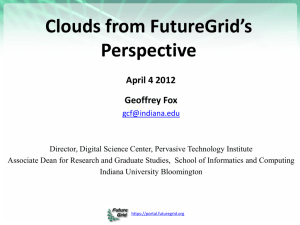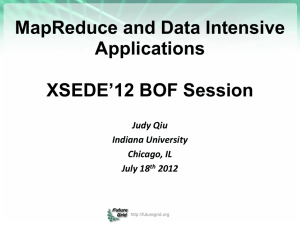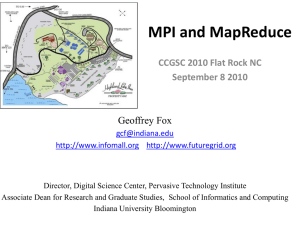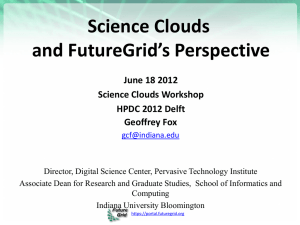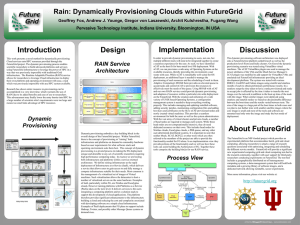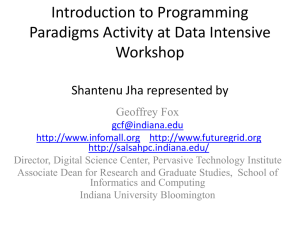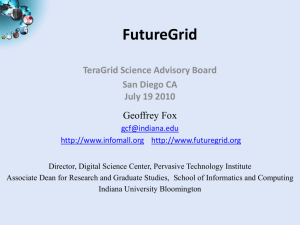FutureGrid and Cyberinfrastructure supporting Data Analysis
advertisement
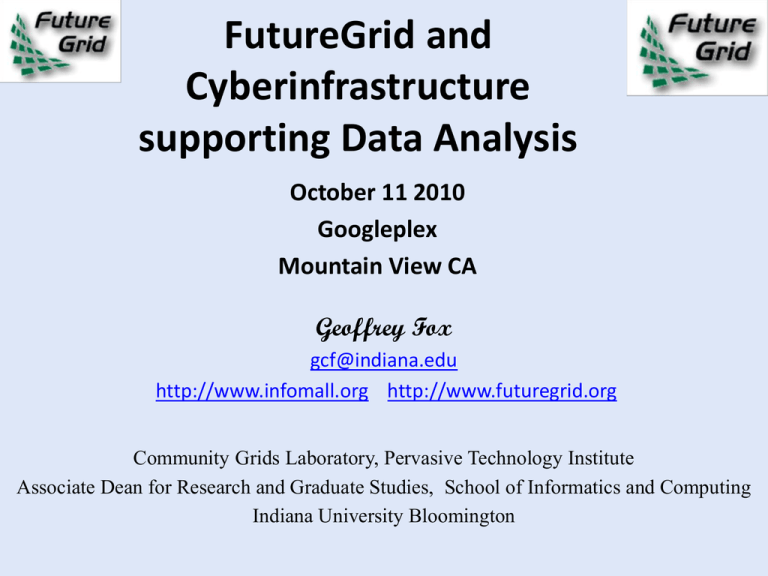
FutureGrid and
Cyberinfrastructure
supporting Data Analysis
October 11 2010
Googleplex
Mountain View CA
Geoffrey Fox
gcf@indiana.edu
http://www.infomall.org http://www.futuregrid.org
Community Grids Laboratory, Pervasive Technology Institute
Associate Dean for Research and Graduate Studies, School of Informatics and Computing
Indiana University Bloomington
Abstract
• TeraGrid has been NSF's production environment typified by large scale
scientific computing simulations typically using MPI.
• Recently TeraGrid has added three experimental environments:
Keeneland (a GPGPU cluster), Gordon (a distributed shared memory
cluster with SSD disks aimed at data analysis and visualization), and
FutureGrid.
• Futuregrid is a small distributed set of clusters (~5000 cores) supporting
HPC, Cloud and Grid computing experiments for both applications and
computer science.
• Users can request arbitrary configurations and those FutureGrid nodes
are rebooted on demand from a library of certified images.
• FutureGrid will in particular allow traditional Grid and MPI researchers
to explore the value of new technologies such as MapReduce, Bigtable
and basic cloud VM infrastructure.
• Further it supports development of the needed new approaches to data
intensive applications which have typically not used TeraGrid. we give
some examples of MPI and Mapreduce applications in gene sequencing
problems.
US Cyberinfrastructure
Context
• There are a rich set of facilities
– Production TeraGrid facilities with distributed and
shared memory
– Experimental “Track 2D” Awards
• FutureGrid: Distributed Systems experiments cf. Grid5000
• Keeneland: Powerful GPU Cluster
• Gordon: Large (distributed) Shared memory system with
SSD aimed at data analysis/visualization
– Open Science Grid aimed at High Throughput
computing and strong campus bridging
http://futuregrid.org
3
TeraGrid
• ~2 Petaflops; over 20 PetaBytes of storage (disk
and tape), over 100 scientific data collections
UW
Grid Infrastructure Group
(UChicago)
UC/ANL
PSC
NCAR
PU
NCSA
Caltech
USC/ISI
IU
ORNL
NICS
SDSC
TACC
LONI
Resource Provider (RP)
Software Integration Partner
Network Hub
4
TeraGrid ‘10
August 2-5, 2010, Pittsburgh, PA
UNC/RENCI
5
Keeneland – NSF-Funded Partnership to Enable Largescale Computational Science on Heterogeneous
Architectures
• NSF Track 2D System of Innovative
Design
–
–
–
–
Georgia Tech
UTK NICS
ORNL
UTK
• Exploit graphics processors to
provide extreme performance
and energy efficiency Prof. Jeffrey S. Vetter
NVIDIA’s new Fermi GPU
Prof. Richard Fujimoto
Prof. Karsten Schwan
Prof. Jack Dongarra
• Two GPU clusters
– Initial delivery (~250 CPU, 250 GPU)
• Being built now; Expected availability is
November 2010
– Full scale (> 500 GPU) – Spring 2012
– NVIDIA, HP, Intel, Qlogic
• Operations, user support
• Education, Outreach, Training for
scientists, students, industry
• Software tools, application
development
http://keeneland.gatech.edu
http://ft.ornl.gov
Dr. Thomas Schulthess
Prof. Sudha Yalamanchili
Jeremy Meredith
Dr. Philip Roth
Richard Glassbrook
Patricia Kovatch
Stephen McNally
Dr. Bruce Loftis
Jim Ferguson
James Rogers
Kathlyn Boudwin
Arlene Washington
Many others…
http://futuregrid.org
6
http://futuregrid.org
7
FutureGrid key Concepts I
• FutureGrid is an international testbed modeled on Grid5000
• Rather than loading images onto VM’s, FutureGrid supports Cloud,
Grid and Parallel computing environments by dynamically
provisioning software as needed onto “bare-metal” using
Moab/xCAT
– Image library for MPI, OpenMP, Hadoop, Dryad, gLite, Unicore, Globus,
Xen, ScaleMP (distributed Shared Memory), Nimbus, Eucalyptus,
OpenNebula, KVM, Windows …..
• The FutureGrid testbed provides to its users:
– A flexible development and testing platform for middleware and application
users looking at interoperability, functionality and performance
– Each use of FutureGrid is an experiment that is reproducible
– A rich education and teaching platform for advanced cyberinfrastructure
classes
• Growth comes from users depositing novel images in library
Dynamic Provisioning
Results
Total Provisioning Time minutes
Time minutes
0:04:19
0:03:36
0:02:53
0:02:10
Time
0:01:26
0:00:43
0:00:00
4
8
Number of nodes
16
32
Time elapsed between requesting a job and the jobs reported start
time on the provisioned node. The numbers here are an average of 2
sets of experiments.
FutureGrid key Concepts II
• Support Computer Science and Computational Science
– Industry and Academia
– Europe and USA
• FutureGrid has ~5000 distributed cores with a dedicated network and
a Spirent XGEM network fault and delay generator
• Key early user oriented milestones:
– June 2010 Initial users
– November 2010-September 2011 Increasing number of users
allocated by FutureGrid
– October 2011 FutureGrid allocatable via TeraGrid process
– 3 classes using FutureGrid this fall
• Apply now to use FutureGrid on web site www.futuregrid.org
FutureGrid Partners
•
•
•
•
•
•
•
•
•
•
•
Indiana University (Architecture, core software, Support)
– Collaboration between research and infrastructure groups
Purdue University (HTC Hardware)
San Diego Supercomputer Center at University of California San Diego
(INCA, Monitoring)
University of Chicago/Argonne National Labs (Nimbus)
University of Florida (ViNE, Education and Outreach)
University of Southern California Information Sciences (Pegasus to manage
experiments)
University of Tennessee Knoxville (Benchmarking)
University of Texas at Austin/Texas Advanced Computing Center (Portal)
University of Virginia (OGF, Advisory Board and allocation)
Center for Information Services and GWT-TUD from Technische Universtität
Dresden. (VAMPIR)
Red institutions have FutureGrid hardware
FutureGrid: a Grid/Cloud/HPC
Testbed
•
•
•
Operational: IU Cray operational; IU , UCSD, UF & UC IBM iDataPlex operational
INCA Node Operating Mode Statistics
Network, NID operational
TACC Dell finished acceptance tests
NID: Network
Private
FG Network
Public
Impairment Device
Network & Internal
Interconnects
• FutureGrid has dedicated network (except to TACC) and a network
fault and delay generator
• Can isolate experiments on request; IU runs Network for
NLR/Internet2
• (Many) additional partner machines will run FutureGrid software
and be supported (but allocated in specialized ways)
Machine
Name
Internal Network
IU Cray
xray
Cray 2D Torus SeaStar
IU iDataPlex
india
DDR IB, QLogic switch with Mellanox ConnectX adapters Blade
Network Technologies & Force10 Ethernet switches
SDSC
iDataPlex
sierra
DDR IB, Cisco switch with Mellanox ConnectX adapters Juniper
Ethernet switches
UC iDataPlex
hotel
DDR IB, QLogic switch with Mellanox ConnectX adapters Blade
Network Technologies & Juniper switches
UF iDataPlex
foxtrot
Gigabit Ethernet only (Blade Network Technologies; Force10 switches)
TACC Dell
alamo
QDR IB, Mellanox switches and adapters Dell Ethernet switches
Network Impairment Device
• Spirent XGEM Network Impairments Simulator for
jitter, errors, delay, etc
• Full Bidirectional 10G w/64 byte packets
• up to 15 seconds introduced delay (in 16ns
increments)
• 0-100% introduced packet loss in .0001% increments
• Packet manipulation in first 2000 bytes
• up to 16k frame size
• TCL for scripting, HTML for manual configuration
FutureGrid Usage Model
• The goal of FutureGrid is to support the research on the future of
distributed, grid, and cloud computing
• FutureGrid will build a robustly managed simulation environment
and test-bed to support the development and early use in science
of new technologies at all levels of the software stack: from
networking to middleware to scientific applications
• The environment will mimic TeraGrid and/or general parallel and
distributed systems – FutureGrid is part of TeraGrid (but not part
of formal TeraGrid process for first two years)
– Supports Grids, Clouds, and classic HPC
– It will mimic commercial clouds (initially IaaS not PaaS)
– Expect FutureGrid PaaS to grow in importance
• FutureGrid can be considered as a (small ~5000 core)
Science/Computer Science Cloud but it is more accurately a virtual
machine or bare-metal based simulation environment
• This test-bed will succeed if it enables major advances in science
and engineering through collaborative development of science
applications and related software
Some Current FutureGrid
Two Recent Projects
early uses
•
•
•
•
•
•
•
•
•
•
•
•
•
•
•
•
Investigate metascheduling approaches on Cray and iDataPlex
Deploy Genesis II and Unicore end points on Cray and iDataPlex clusters
Develop new Nimbus cloud capabilities
Prototype applications (BLAST) across multiple FutureGrid clusters and Grid’5000
Compare Amazon, Azure with FutureGrid hardware running Linux, Linux on Xen or Windows
for data intensive applications
Test ScaleMP software shared memory for genome assembly
Develop Genetic algorithms on Hadoop for optimization
Attach power monitoring equipment to iDataPlex nodes to study power use versus use
characteristics
Industry (Columbus IN) running CFD codes to study combustion strategies to maximize
energy efficiency
Support evaluation needed by XD TIS and TAS services
Investigate performance of Kepler workflow engine
Study scalability of SAGA in difference latency scenarios
Test and evaluate new algorithms for phylogenetics/systematics research in CIPRES portal
Investigate performance overheads of clouds in parallel and distributed environments
Support tutorials and classes in cloud, grid and parallel computing (IU, Florida, LSU)
~12 active/finished users out of ~32 early user applicants
Grid Interoperability
from Andrew Grimshaw
• Colleagues,
• FutureGrid has as two of its many goals the creation of a Grid middleware testing
and interoperability testbed as well as the maintenance of standards compliant
endpoints against which experiments can be executed. We at the University of
Virginia are tasked with bringing up three stacks as well as maintaining standardendpoints against which these experiments can be run.
• We currently have UNICORE 6 and Genesis II endpoints functioning on X-Ray (a
Cray). Over the next few weeks we expect to bring two additional resources, India
and Sierra (essentially Linux clusters), on-line in a similar manner (Genesis II is
already up on Sierra). As called for in the FutureGrid program execution plan,
once those two stacks are operational we will begin to work on g-lite (with help
we may be able to accelerate that). Other standards-compliant endpoints are
welcome in the future , but not part of the current funding plan.
• RENKEI/NAREGI
I’m writing the PGI
and are
GINinterested
working groups
see if therefor
is interest
in using
We
project
in the to
participation
interoperation
these resources
(endpoints)
as aand
part
either
GIN or PGImiddleware
work, in particular
demonstrations
or projects
for OGF
SC.ofWe
havethe
a prototype
which
in demonstrations or projects for OGF in October or SC in November. One of the
can submit
and receive
jobs using
HPCBP specification.
have
detailed
key differences
between
thesethe
endpoints
and others isCan
thatwe
they
canmore
be expected
information
of your
data
staging
method,
andThey
so on)
to persist.
Theseendpoints(authentication,
resources will not go away
when
a demo
is done.
willand
be
there as a testbed
for future
and middleware development (e.g., a
the participation
conditions
of theapplication
demonstrations/projects.
metascheduler that works across g-lite and Unicore 6).
http://futuregrid.org
17
OGF’10 Demo
SDSC
Rennes
Grid’5000
firewall
Lille
UF
UC
ViNe provided the necessary
inter-cloud connectivity to
deploy CloudBLAST across 5
Nimbus sites, with a mix of
public and private subnets.
Sophia
300+ Students learning about Twister & Hadoop
MapReduce technologies, supported by FutureGrid.
July 26-30, 2010 NCSA Summer School Workshop
http://salsahpc.indiana.edu/tutorial
Washington
University
University of
Minnesota
Iowa
State
IBM Almaden
Research Center
University of
California at
Los Angeles
San Diego
Supercomputer
Center
Michigan
State
Univ.Illinois
at Chicago
Notre
Dame
Johns
Hopkins
Penn
State
Indiana
University
University of
Texas at El Paso
University of
Arkansas
University
of Florida
Software Components
• Portals including “Support” “use FutureGrid”
“Outreach”
• Monitoring – INCA, Power (GreenIT)
• Experiment Manager: specify/workflow
• Image Generation and Repository
• Intercloud Networking ViNE
• Virtual Clusters built with virtual networks
• Performance library
• Rain or Runtime Adaptable InsertioN Service: Schedule
and Deploy images
• Security (including use of isolated network),
Authentication, Authorization,
FutureGrid
Layered Software
Stack
User Supported Software usable in Experiments
e.g. OpenNebula, Charm++, Other MPI, Bigtable
http://futuregrid.org
21
FutureGrid Interaction with
Commercial Clouds
• We support experiments that link Commercial Clouds and FutureGrid
with one or more workflow environments and portal technology installed
to link components across these platforms
• We support environments on FutureGrid that are similar to Commercial
Clouds and natural for performance and functionality comparisons
– These can both be used to prepare for using Commercial Clouds and as
the most likely starting point for porting to them
– One example would be support of MapReduce-like environments on
FutureGrid including Hadoop on Linux and Dryad on Windows HPCS which
are already part of FutureGrid portfolio of supported software
• We develop expertise and support porting to Commercial Clouds from
other Windows or Linux environments
• We support comparisons between and integration of multiple
commercial Cloud environments – especially Amazon and Azure in the
immediate future
• We develop tutorials and expertise to help users move to Commercial
Clouds from other environments
194 papers submitted to main track; 48 accepted; 4 days of tutorials including OpenNebula
Scientific Computing Architecture
• Traditional Supercomputers (TeraGrid and DEISA) for large scale parallel computing
– mainly simulations
– Likely to offer major GPU enhanced systems
• Traditional Grids for handling distributed data – especially instruments and sensors
• Clouds for “high throughput computing” including much data analysis and
emerging areas such as Life Sciences using loosely coupled parallel computations
– May offer small clusters for MPI style jobs
– Certainly offer MapReduce
• What is architecture for data analysis?
– MapReduce Style? Certainly good in several cases
– MPI Style? Data analysis uses linear algeabra, iterative EM
– Shared Memory? NSF Gordon
• Integrating these needs new work on distributed file systems and high quality data
transfer service
– Link Lustre WAN, Amazon/Google/Hadoop/Dryad File System
– Offer Bigtable
Application Classes
Old classification of Parallel software/hardware in terms of
5 (becoming 6) “Application architecture” Structures)
1
Synchronous
Lockstep Operation as in SIMD architectures
SIMD
2
Loosely
Synchronous
Iterative Compute-Communication stages with
independent compute (map) operations for each CPU.
Heart of most MPI jobs
MPP
3
Asynchronous
Computer Chess; Combinatorial Search often supported
by dynamic threads
MPP
4
Pleasingly Parallel
Each component independent – in 1988, Fox estimated
at 20% of total number of applications
Grids
5
Metaproblems
Coarse grain (asynchronous) combinations of classes 1)4). The preserve of workflow.
Grids
6
MapReduce and
Enhancements
It describes file(database) to file(database) operations
which has subcategories including.
1) Pleasingly Parallel Map Only
2) Map followed by reductions
3) Iterative “Map followed by reductions” –
Extension of Current Technologies that
supports much linear algebra and data mining
Clouds
Hadoop/
Dryad
Twister
Pregel
Applications & Different Interconnection Patterns
Map Only
Input
map
Classic
MapReduce
Input
map
Iterative Reductions
MapReduce++
Input
map
Loosely
Synchronous
iterations
Pij
Output
reduce
reduce
CAP3 Analysis
Document conversion
(PDF -> HTML)
Brute force searches in
cryptography
Parametric sweeps
High Energy Physics
(HEP) Histograms
SWG gene alignment
Distributed search
Distributed sorting
Information retrieval
Expectation
maximization algorithms
Clustering
Linear Algebra
Many MPI scientific
applications utilizing
wide variety of
communication
constructs including
local interactions
- CAP3 Gene Assembly
- PolarGrid Matlab data
analysis
- Information Retrieval HEP Data Analysis
- Calculation of Pairwise
Distances for ALU
Sequences
- Kmeans
- Deterministic
Annealing Clustering
- Multidimensional
Scaling MDS
- Solving Differential
Equations and
- particle dynamics
with short range forces
Domain of MapReduce and Iterative Extensions
MPI
What hardware/software is
needed for data analysis?
• Largest compute systems in world are commercial systems
used for internet and commerce data analysis
• Largest US academic systems (TeraGrid) are essentially not
used for data analysis
– Open Science Grid and EGI (European Grid Initiative) have large
CERN LHC data analysis component – largely pleasingly parallel
problems
– TeraGrid “data systems” shared memory
• Runtime models
– “Dynamic Scheduling”, MapReduce, MPI …. (when they work,
all ~same performance)
• Agreement on architecture for large scale simulation
(GPGPU relevance question of detail); little consensus on
scientific data analysis architecture
http://futuregrid.org
27
European Grid Infrastructure
Status April 2010 (yearly increase)
• 10000 users: +5%
• 243020 LCPUs (cores): +75%
• 40PB disk: +60%
• 61PB tape: +56%
• 15 million jobs/month: +10%
• 317 sites: +18%
• 52 countries: +8%
• 175 VOs: +8%
• 29 active VOs: +32%
1/10/2010
EGI-InSPIRE RI-261323
NSF & EC - Rome 2010
28
www.egi.eu
Performance Study
MapReduce v Scheduling
Linux,
Linux on VM,
Windows,
Azure,
Amazon
on
Bioinformatics
29
Hadoop/Dryad Comparison
Inhomogeneous Data I
Randomly Distributed Inhomogeneous Data
Mean: 400, Dataset Size: 10000
1900
1850
Time (s)
1800
1750
1700
1650
1600
1550
1500
0
50
100
150
200
250
300
Standard Deviation
DryadLinq SWG
Hadoop SWG
Hadoop SWG on VM
Inhomogeneity of data does not have a significant effect when the sequence
lengths are randomly distributed
Dryad with Windows HPCS compared to Hadoop with Linux RHEL on Idataplex (32 nodes)
Scaled Timing with
Azure/Amazon MapReduce
Cap3 Sequence Assembly
1900
1800
1700
Time (s)
1600
1500
1400
1300
1200
Azure MapReduce
Amazon EMR
Hadoop Bare Metal
Hadoop on EC2
1100
1000
Number of Cores * Number of files
AzureMapReduce
Smith Waterman
MPI DryadLINQ Hadoop
Time per Actual Calculation (ms)
0.025
0.020
0.015
0.010
Hadoop SW-G
0.005
MPI SW-G
DryadLINQ SW-G
0.000
10000
20000
30000
No. of Sequences
Hadoop is Java; MPI and Dryad are C#
40000
Parallel Data Analysis
Algorithms
Developed a suite of parallel data-analysis capabilities using
deterministic annealing
Clustering
Vector based O(N)
Distance based O(N2)
Dimension Reduction for visualization and analysis
Vector based Generative Topographic Map GTM O(N)
Distance based Multidimensional Scaling MDS O(N2)
All have faster hierarchical (interpolation) algorithms
All with deterministic annealing (DA)
Easy to parallelize but linear algebra/Iterative EM – need MPI
Typical Application Challenge:
DNA Sequencing Pipeline
MapReduce
Pairwise
clustering
FASTA File
N Sequences
Blocking
block
Pairings
Sequence
Alignment/
Assembly
Dissimilarity
Matrix
MPI
Visualization
N(N-1)/2 values
MDS
Read
Alignment
Illumina/Solexa
Roche/454 Life Sciences
Applied Biosystems/SOLiD
Internet
Modern Commercial Gene Sequencers
Linear Algebra or Expectation Maximization based data mining poor
on MapReduce – equivalent to using MPI writing messages to disk and
restarting processes each step/iteration of algorithm
Metagenomics
This visualizes results of
dimension reduction to
3D of 30000 gene
sequences from an
environmental sample.
The many different
genes are classified by
clustering algorithm and
visualized by MDS
dimension reduction
General Deterministic Annealing Formula
N data points E(x) in D dimensions space and minimize F by EM
N
F T p( x) ln{ k 1 exp[( E ( x) Y ( k )) 2 / T ]
K
x 1
Deterministic Annealing Clustering (DAC)
• F is Free Energy (E(x) is energy to be minimized)
• p(x) with p(x) =1
• T is annealing temperature varied down from with final
value of 1
• Determine cluster centerY(k) by EM method
• EM is well known expectation maximization method
corresponding to steepest descent
• K (number of clusters) starts at 1 and is incremented by
algorithm
Deterministic Annealing I
• Gibbs Distribution at Temperature T
P() = exp( - H()/T) / d exp( - H()/T)
• Or P() = exp( - H()/T + F/T )
• Minimize Free Energy
F = < H - T S(P) > = d {P()H + T P() lnP()}
• Where are (a subset of) parameters to be minimized
• Simulated annealing corresponds to doing these integrals by
Monte Carlo
• Deterministic annealing corresponds to doing integrals
analytically and is naturally much faster
• In each case temperature is lowered slowly – say by a factor
0.99 at each iteration
Deterministic
Annealing
F({y}, T)
Solve Linear
Equations for
each temperature
Nonlinearity
effects mitigated
by initializing
with solution at
previous higher
temperature
Configuration {y}
•
Minimum evolving as temperature decreases
•
Movement at fixed temperature going to local minima if
not initialized “correctly
Deterministic Annealing II
• For some cases such as vector clustering and Gaussian Mixture
Models one can do integrals by hand but usually will be
impossible
• So introduce Hamiltonian H0(, ) which by choice of can be
made similar to H() and which has tractable integrals
• P0() = exp( - H0()/T + F0/T ) approximate Gibbs
• FR (P0) = < HR - T S0(P0) >|0 = < HR – H0> |0 + F0(P0)
• Where <…>|0 denotes d Po()
• Easy to show that real Free Energy
FA (PA) ≤ FR (P0)
• In many problems, decreasing temperature is classic multiscale –
finer resolution (T is “just” distance scale)
• Related to variational inference
40
Implementation of DA I
• Expectation step E is find minimizing FR (P0) and
• Follow with M step setting = <> |0 = d Po() and
if one does not anneal over all parameters and one
follows with a traditional minimization of remaining
parameters
• In clustering, one then looks at second derivative
matrix of FR (P0) wrt and as temperature is lowered
this develops negative eigenvalue corresponding to
instability
• This is a phase transition and one splits cluster into
two and continues EM iteration
• One starts with just one cluster
41
Rose, K., Gurewitz, E., and Fox, G. C.
``Statistical mechanics and phase transitions
in clustering,'' Physical Review Letters,
65(8):945-948, August 1990.
My #5 my most cited article (311)
42
Implementation II
• Clustering variables are Mi(k) where this is probability point i
belongs to cluster k
• In Clustering, take H0 = i=1N k=1K Mi(k) i(k)
• <Mi(k)> = exp( -i(k)/T ) / k=1K exp( -i(k)/T )
• Central clustering has i(k) = (X(i)- Y(k))2 and i(k) determined by
Expectation step in pairwise clustering
– HCentral = i=1N k=1K Mi(k) (X(i)- Y(k))2
– Hcentral and H0 are identical
– Centers Y(k) are determined in M step
•
•
•
•
Pairwise Clustering given by nonlinear form
HPC = 0.5 i=1N j=1N (i, j) k=1K Mi(k) Mj(k) / C(k)
with C(k) = i=1N Mi(k) as number of points in Cluster k
And now H0 and HPC are different
43
Multidimensional Scaling MDS
• Map points in high dimension to lower dimensions
• Many such dimension reduction algorithm (PCA Principal component
analysis easiest); simplest but perhaps best is MDS
• Minimize Stress
(X) = i<j=1n weight(i,j) (ij - d(Xi , Xj))2
• ij are input dissimilarities and d(Xi , Xj) the Euclidean distance squared in
embedding space (3D usually)
• SMACOF or Scaling by minimizing a complicated function is clever steepest
descent (expectation maximization EM) algorithm
• Computational complexity goes like N2. Reduced Dimension
• There is Deterministic annealed version of it
• Could just view as non linear 2 problem (Tapia et al. Rice)
• All will/do parallelize with high efficiency
Implementation III
• One tractable form was a linear Hamiltonian
• Another is Gaussian H0 = i=1n (X(i) - (i))2 / 2
• Where X(i) are vectors to be determined as in formula for
Multidimensional scaling
• HMDS = i< j=1n weight(i,j) ((i, j) - d(X(i) , X(j) ))2
• Where (i, j) are observed dissimilarities and we want to
represent as Euclidean distance between points X(i) and X(j)
(HMDS is quartic or involves square roots)
• The E step is minimize
i< j=1n weight(i,j) ((i, j) – constant.T - ((i) - (j))2 )2
• with solution (i) = 0 at large T
• Points pop out from origin as Temperature lowered
45
MPI & Iterative MapReduce papers
•
•
•
•
•
•
MapReduce on MPI Torsten Hoefler, Andrew Lumsdaine and Jack Dongarra, Towards
Efficient MapReduce Using MPI, Recent Advances in Parallel Virtual Machine and
Message Passing Interface Lecture Notes in Computer Science, 2009, Volume
5759/2009, 240-249
MPI with generalized MapReduce
Jaliya Ekanayake, Hui Li, Bingjing Zhang, Thilina Gunarathne, Seung-Hee Bae, Judy Qiu,
Geoffrey Fox Twister: A Runtime for Iterative MapReduce, Proceedings of the First
International Workshop on MapReduce and its Applications of ACM HPDC 2010
conference, Chicago, Illinois, June 20-25, 2010
http://grids.ucs.indiana.edu/ptliupages/publications/twister__hpdc_mapreduce.pdf
http://www.iterativemapreduce.org/
Grzegorz Malewicz, Matthew H. Austern, Aart J. C. Bik, James C. Dehnert, Ilan Horn,
Naty Leiser, and Grzegorz Czajkowski Pregel: A System for Large-Scale Graph Processing,
Proceedings of the 2010 international conference on Management of data Indianapolis,
Indiana, USA Pages: 135-146 2010
Yingyi Bu, Bill Howe, Magdalena Balazinska, Michael D. Ernst HaLoop: Efficient Iterative
Data Processing on Large Clusters, Proceedings of the VLDB Endowment, Vol. 3, No. 1,
The 36th International Conference on Very Large Data Bases, September 1317, 2010,
Singapore.
Matei Zaharia, Mosharaf Chowdhury, Michael J. Franklin, Scott Shenker, Ion Stoica
Spark: Cluster Computing with Working Sets poster at
http://radlab.cs.berkeley.edu/w/upload/9/9c/Spark-retreat-poster-s10.pdf
Twister
Pub/Sub Broker Network
Worker Nodes
D
D
M
M
M
M
R
R
R
R
Data Split
MR
Driver
M Map Worker
User
Program
R
Reduce Worker
D
MRDeamon
•
•
Data Read/Write
File System
Communication
•
•
•
•
Static
data
Streaming based communication
Intermediate results are directly
transferred from the map tasks to the
reduce tasks – eliminates local files
Cacheable map/reduce tasks
• Static data remains in memory
Combine phase to combine reductions
User Program is the composer of
MapReduce computations
Extends the MapReduce model to
iterative computations
Iterate
Configure()
User
Program
Map(Key, Value)
δ flow
Reduce (Key, List<Value>)
Combine (Key, List<Value>)
Different synchronization and intercommunication
mechanisms used by the parallel runtimes
Close()
Iterative and non-Iterative Computations
K-means
Smith Waterman is a non iterative
case and of course runs fine
Performance of K-Means
Matrix Multiplication 64 cores
Square blocks
Twister
Row/Col decomp
Twister
Square blocks
OpenMPI
Overhead OpenMPI v Twister
negative overhead due to cache
http://futuregrid.org
50
Performance of Pagerank using
ClueWeb Data (Time for 20 iterations)
using 32 nodes (256 CPU cores) of Crevasse
Fault Tolerance and MapReduce
• MPI does “maps” followed by “communication” including
“reduce” but does this iteratively
• There must (for most communication patterns of interest) be
a strict synchronization at end of each communication phase
– Thus if a process fails then everything grinds to a halt
• In MapReduce, all Map processes and all reduce processes
are independent and stateless and read and write to disks
– As 1 or 2 (reduce+map) iterations, no difficult synchronization
issues
• Thus failures can easily be recovered by rerunning process
without other jobs hanging around waiting
• Re-examine MPI fault tolerance in light of MapReduce
– Relevant for Exascale?
• Re-examine MapReduce in light of MPI experience …..
TwisterMPIReduce
PairwiseClustering
MPI
Multi Dimensional
Scaling MPI
Generative
Topographic Mapping
MPI
Other …
TwisterMPIReduce
Azure Twister (C# C++)
Microsoft Azure
Java Twister
FutureGrid
Local
Cluster
Amazon
EC2
• Runtime package supporting subset of MPI
mapped to Twister
• Set-up, Barrier, Broadcast, Reduce
Some Issues with AzureTwister
and AzureMapReduce
• Transporting data to Azure: Blobs (HTTP), Drives
(GridFTP etc.), Fedex disks
• Intermediate data Transfer: Blobs (current choice)
versus Drives (should be faster but don’t seem to be)
• Azure Table v Azure SQL: Handle all metadata
• Messaging Queues: Use real publish-subscribe system
in place of Azure Queues to get scaling (?) with multiple
brokers – especially AzureTwister
• Azure Affinity Groups: Could allow better data-compute
and compute-compute affinity
Research Issues
• Clouds are suitable for “Loosely coupled” data parallel applications
• “Map Only” (really pleasingly parallel) certainly run well on clouds
(subject to data affinity) with many programming paradigms
• Parallel FFT and adaptive mesh PDE solver very bad on MapReduce
but suitable for classic MPI engines.
• MapReduce is more dynamic and fault tolerant than MPI; it is
simpler and easier to use
• Is there an intermediate class of problems for which Iterative
MapReduce useful?
–
–
–
–
–
–
–
Long running processes?
Mutable data small in size compared to fixed data(base)?
Only support reductions?
Is it really different from a fault tolerant MPI?
Multicore implementation
Link to HDFS or equivalent data parallel file system
Relation to Exascale fault tolerance
